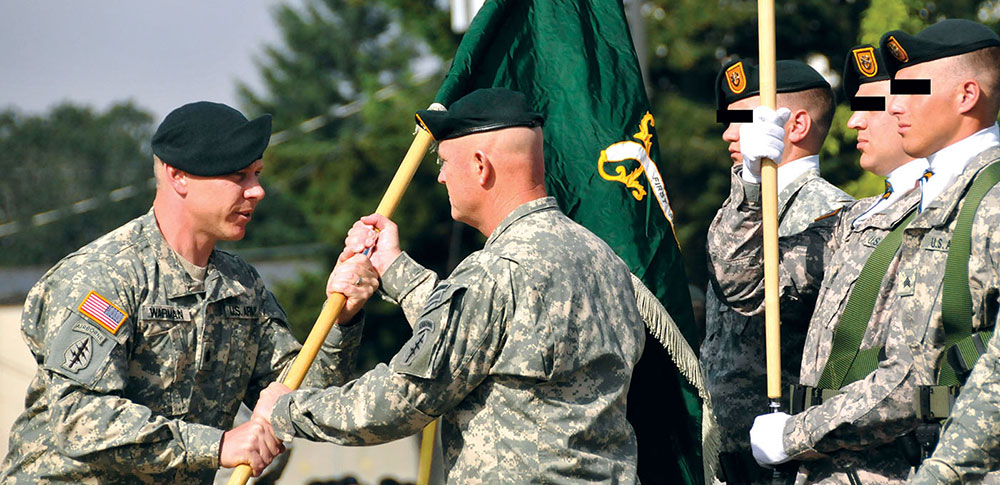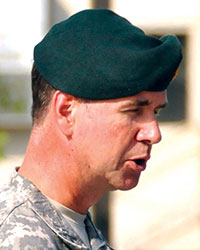Second, the S-1, Captain (CPT) Emily L. Millet*, listed the battalion at 72 percent strength with 314 personnel, and was optimistic about meeting the next milestone of 349 personnel by November. (At full strength, the battalion would have 432 military personnel and 6 civilians.)11 Third, the S-3, Major Yung M. Choe*, remarked that the battalion was reaching its validation and certification benchmarks thanks to ongoing training.12 Fourth, the battalion had 79 percent of its allotted equipment. Finally, the meeting closed after discussing equipment procurement, budgetary matters, and the upcoming activation ceremony.13 LTC Warman later praised the work of the “plank holders in the activation element” during the battalion’s formative stage.14
On 26 August 2011, 4-1st SFG officially activated at JBLM.15 “It is a distinct pleasure for me to serve as reviewing officer for today’s ceremony to activate our 4th Special Forces Battalion,” said COL Vines, in the absence of the 1st SFG commander, COL Francis M. Beaudette, who was in the Republic of the Philippines as the ‘dual-hatted’ commander of the Joint Special Operations Task Force – Philippines (JSOTF-P). In his remarks, Vines explained that “an experienced and dynamic command team has been selected to complete the activation of the battalion, and see it through its full operational capability on the 16th of August 2012.”16

Commanding 4-1st SFG was LTC Steven A. Warman, a 1992 Norwich University graduate and former Field Artillery Officer who later became an SF Officer and deployed multiple times to OEF and OIF.17 According to Vines, LTC Warman “was highly recommended, respected, and talented Special Forces leader [who] has proved himself an outstanding combat leader and a knowledgeable Special Forces operator.”18 Warman’s Senior Enlisted Advisor was Command Sergeant Major (CSM) George L. Hines*, a 1983 Army enlistee who later became SF qualified and held leadership positions from the team level up. His deployments included two to OIF and one to OEF-P.19 COL Vines remarked that Hines* had “excelled as a Special Forces operator and is highly respected within our community … The battalion will quickly benefit from his leadership, and his mentoring and developing of the battalion’s NCOs.”20
LTC Warman had the last words at 4-1st SFG’s activation ceremony: “While this ceremony marks the completion of the stand-up of this battalion, it is only the beginning of its legacy. The reputation of this battalion will be a reflection of the soldiers that stand before you. Your deeds will shape our unit’s history … I challenge us to ensure that the bedrock that we build over the next months will stand forever. We have some work ahead as we accept the mission [to] train, man, and equip eighteen [ODAs] to place on the field of battle … From all accounts, as I look at the men in front of me and the work that you have already accomplished, we are up to the challenge.”21
POSTSCRIPT
4th Battalion, 1st SFG was very active during its provisional stage and in the first year after formal activation, thus validating the need for a fourth battalion. In 2011, Company A, 4-1st SFG hosted Indian Army Special Forces soldiers for a Joint Combined Exchange Training (JCET) exercise at JBLM called VAJRA PRAHAR 2011 (see full article). In addition, an ODA from Company A conducted FID training with the Japan Ground Self Defense Forces, Special Operations Group (JGSDF SOG) as part of exercise SILENT EAGLE. Meanwhile, ODAs from Company B, 4-1st SFG joined 2nd Battalion soldiers in a JCET with Philippine National Police (PNP) to improve counter-narcoterrorism (CNT) capabilities.22
4-1st SFG OPTEMPO picked up in 2012. Two ODAs from Company A deployed to OEF-Afghanistan, with assignment to Special Operations Task Force – Southeast (SOTF-SE), Combined Joint Special Operations Task Force – Afghanistan (CJSOTF-A), to conduct Village Stability Operations (VSO) and FID. Alongside U.S. Marine Corps personnel, Company A, 4-1st SFG soldiers deployed to the Philippines for a JCET with the Philippine Marine Corps 62nd Force Recon Company and Marine Battalion Landing Team (MBLT), to improve host nation capabilities. Other teams deployed to the Philippines to train with such agencies as the 12th Scout Ranger Commandos and the PNP. Also in 2012, Company A personnel conducted FID training with the Singhanath Commando Battalion and Mahabir Ranger Battalion from Nepal, the Taiwanese Army Aviation SF Command (AASFC), and the Malaysian Commandos, as well as CNT training with the Royal Thai Police from Thailand.
Company B personnel deployed to the Philippines for counter-terrorism training with Philippine Security Forces (PSF), and later as assigned members of JSOTF-P. Company C soldiers trained with the PNP in the Philippines; the Anti-Terrorism Platoon, 1st Para Commando Battalion, from Nepal; and the Maldivian National Defense Force. Along with the 4-1st SFG headquarters and teams from 19th SFG, Company C deployed to Thailand for COBRA GOLD 2012, training on UW and FID with the Royal Thai SF.23 The following year, 4-1st SFG elements deployed again to Afghanistan and the Philippines. LTC Owen G. Ray, Warman’s successor as 4-1st SFG commander as of 8 August 2013, stated succinctly: “ODA work is our business, our priority of effort.”24 Simultaneously, the battalion looked for ways to improve its ability to conduct UW across all seven phases (Preparation, Initial Contact, Infiltration, Organization, Buildup, Employment, and Transition).25 From Thailand, to Afghanistan, to the Philippines, to the Maldives, 4th Battalion has proved critical to the 1st SFG mission of conducting Special Operations “throughout the [USPACOM] Area of Responsibility and other theaters … in order to support USPACOM objectives and U.S. national interests.”26



